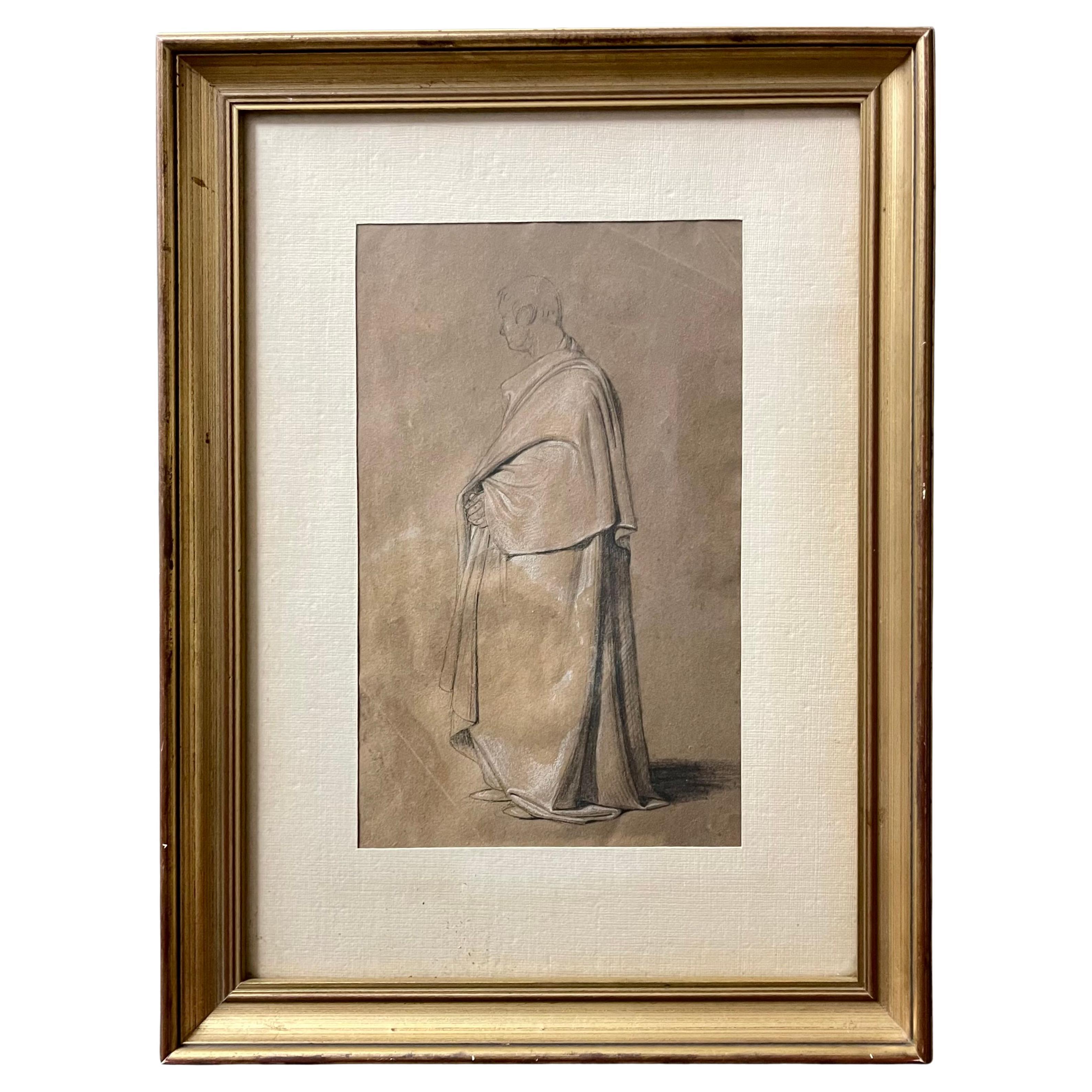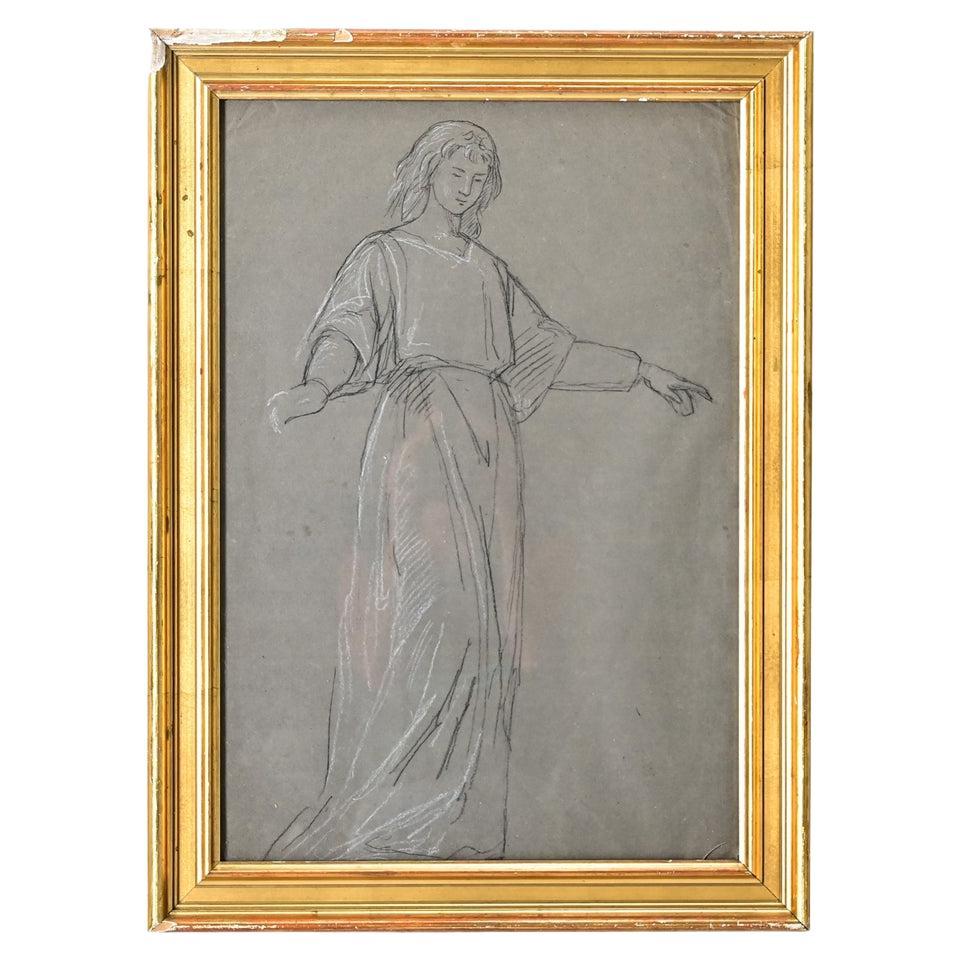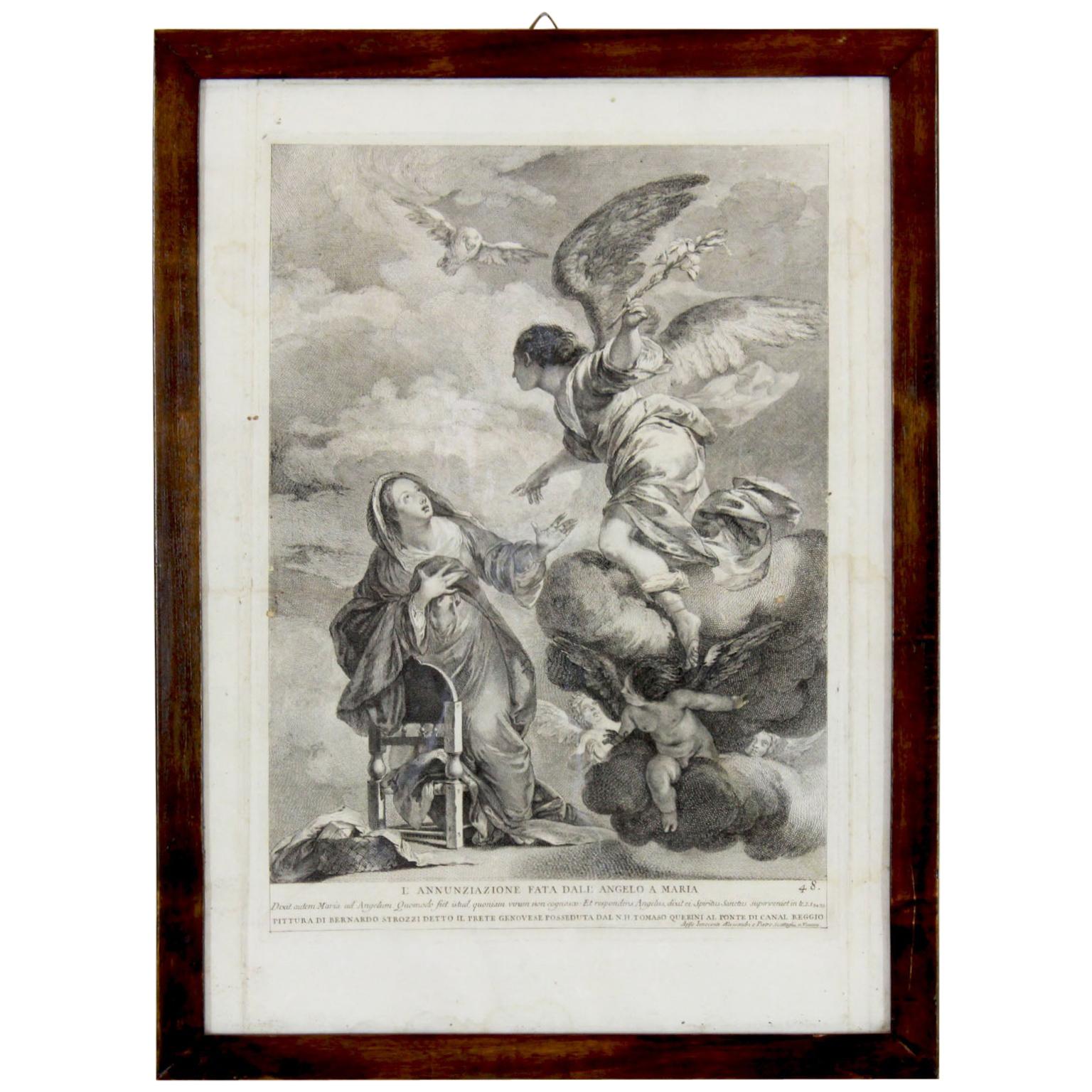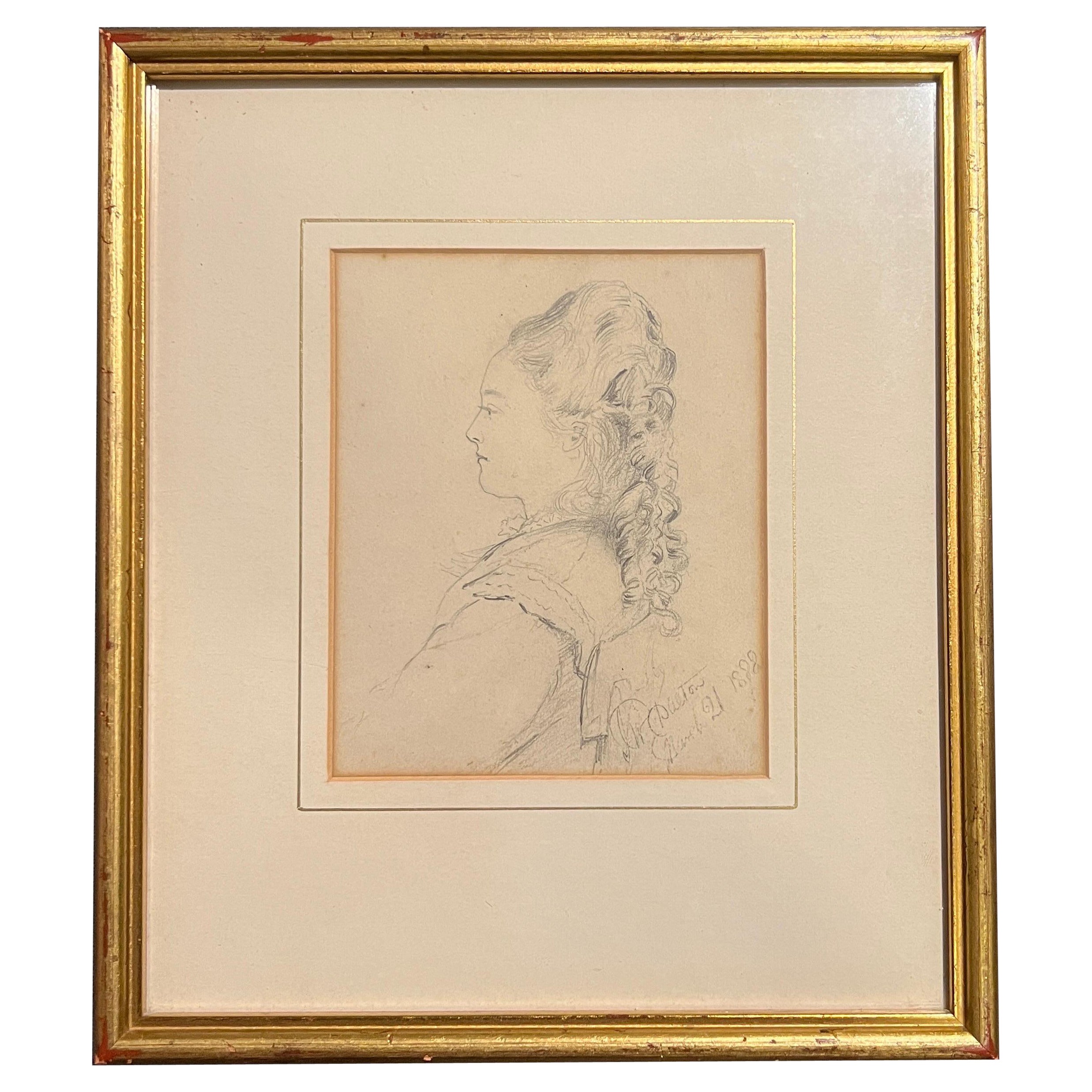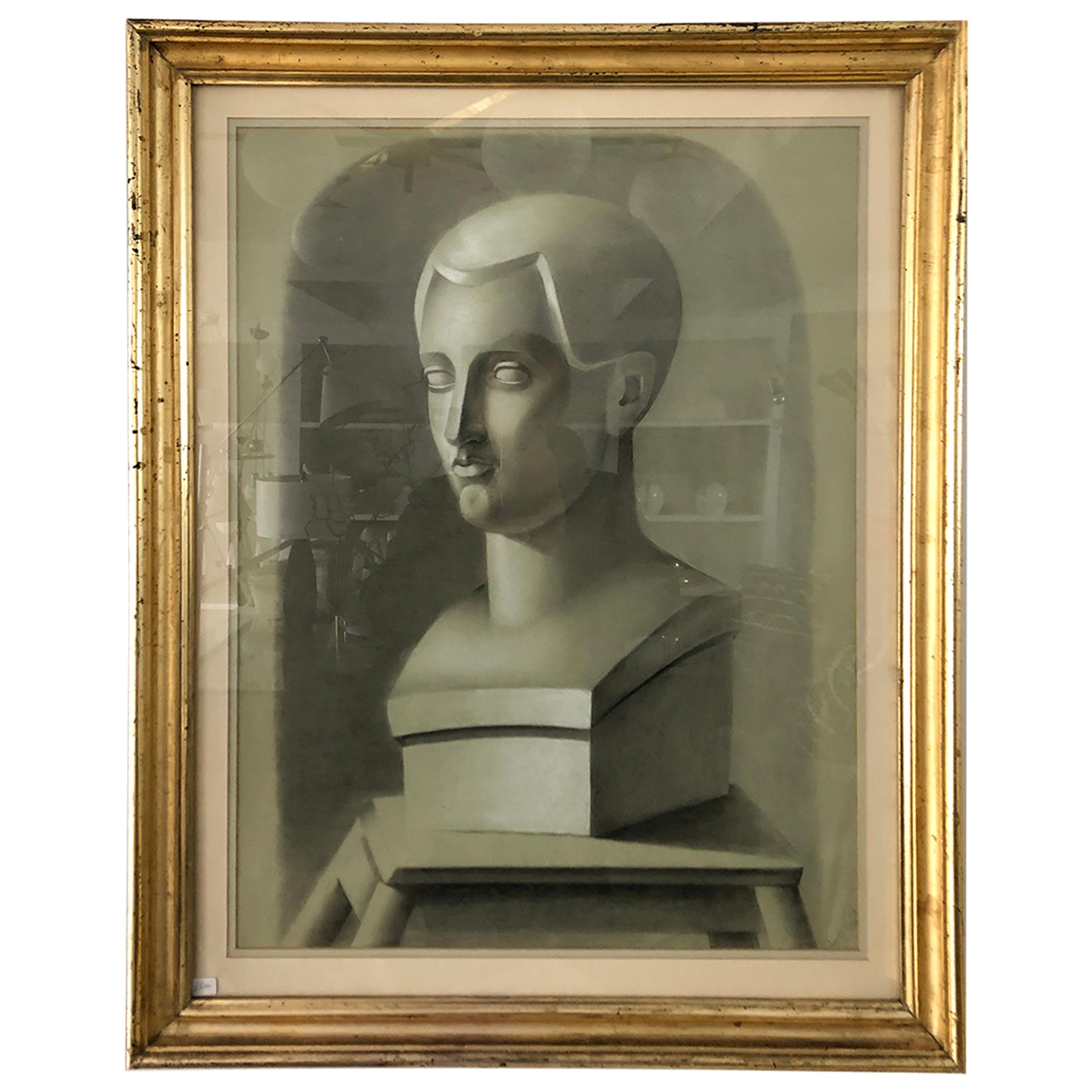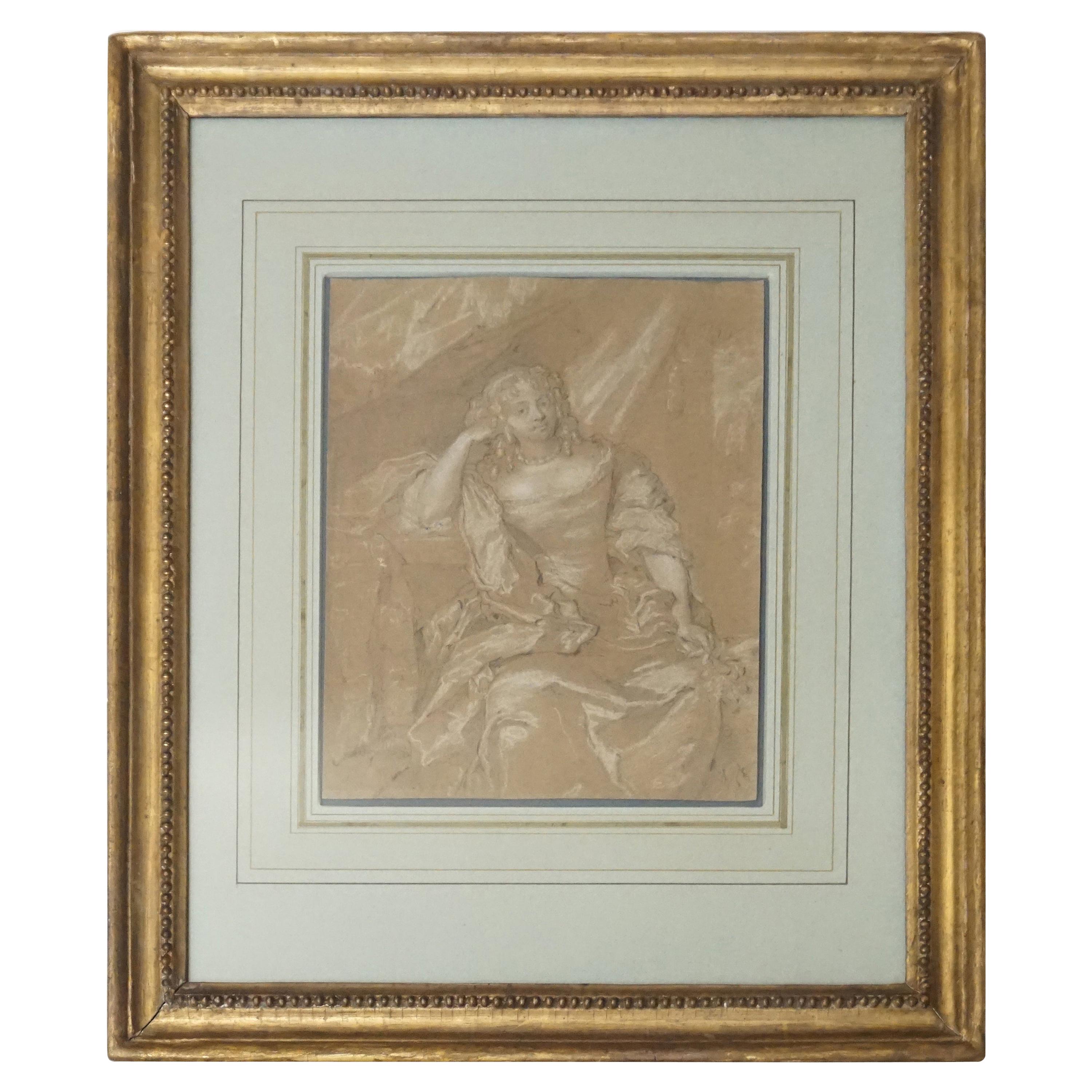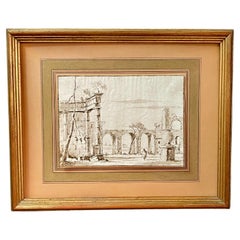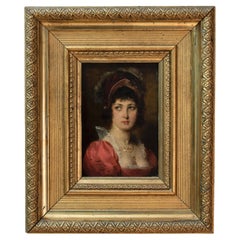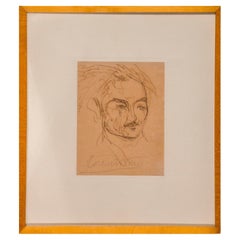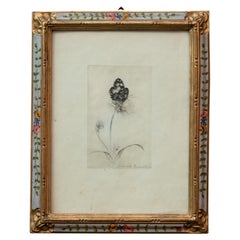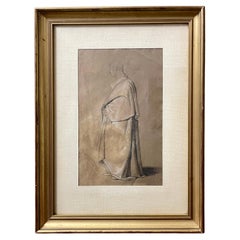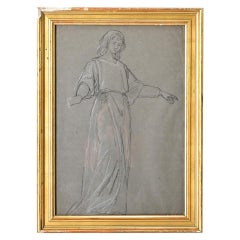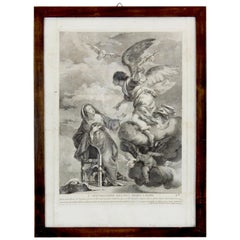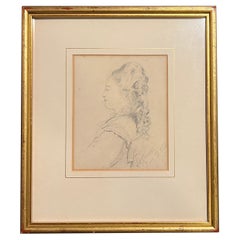Items Similar to Neoclassical Italian Drawing Framed Portrait
Want more images or videos?
Request additional images or videos from the seller
1 of 5
Neoclassical Italian Drawing Framed Portrait
$694.18
£512.07
€580
CA$961.83
A$1,044.36
CHF 553.06
MX$12,800.82
NOK 6,844.37
SEK 6,467.57
DKK 4,415.46
About the Item
Rare and intense pencil on paper drawing attributed to the great 19th century Italian artist Domenico Morelli.
It depicts with strong character a man portrayed in three-quarter view.
Dressed in a tunic of ancient Rome, he is certainly an illustrious personage, perhaps a senator or philosopher.
This artwork, never before on the market, comes from an important private collection and is beautified by an impressive frame in gilded wood, in almost perfect condition.
The artwork is protected by a glass
Domenico Morelli (4 August 1823 – 13 August 1901) was an Italian painter, who mainly produced historical and religious works.
Morelli was immensely influential in the arts of the second half of the 19th century, both as director of the Accademia di Belle Arti in Naples, but also because of his rebelliousness against institutions: traits that flourished into the passionate, often patriotic, Romantic and later Symbolist subjects of his canvases.
Morelli was the teacher of Vincenzo Petrocelli, Ulisse Caputo, and Anselmo Gianfanti.
He was born to a poor family in Naples. His mother had hoped he would become a priest.
His precocious talent was noted, and he was enrolled at the Royal Academy of Fine Arts in Naples in 1836–1846, where he befriended Francesco Altamura.
His early works contain imagery drawn from the Medieval stories and Romantic poets such as Byron.
In 1845, he painted a prize-winning L' angelo che porta le anime al Purgatorio dantesco.
In 1845–46, with the painting of Saul calmato da David, and help from a generous patron, the lawyer Ruggiero, he won a fellowship to study in Rome.
In 1847–48, he painted Il corsaio and Una sfida di Trovatori, the prize-winning Bacio del Corsaro, and Goffredo a cui appare l'angelo.
In 1847 at Rome, he painted a Madonna che culla il bambino, aiutata da San Giovanni.
Morelli had just returned to Naples, when the insurrections of 1848 erupted in Naples.
He joined the protesters in the barricades on via Toledo, and was wounded, nearly killed, and briefly imprisoned.
In a retrospective published after his death, Isabella Anderton would label Domenico as one of the warrior artists of Italy, a group which also included Filippo Palizzi, Telemaco Signorini, Stefano Ussi, and Francesco Saverio Altamura.
Released, Morelli returned to Rome. He painted Van der Welt in mezzo ai corsari sopra una via romita (1851) and Cesare Borgia a Capita in mezzo ad una folla di fanciulle.
In 1855 at the Florentine Exposition, he displayed his famous The Iconoclasts.
He participated in the Universal Exposition in Paris in 1855.
Later, in Florence, he was an active participant in the Macchiaioli discussions on Realism.
Morelli claimed that it was these discussions that made his own work less academic and helped him to develop a freer style and to experiment with color. In this period, he is grouped into the school of Realism.
In 1857, he won a contest to design the decoration of the Church of San Francesco of Gaeta, a project never completed.
On a trip to Milan he painted Count di Ijara, Pompeian Bath, and a Madonna Addolorata.
By 1857, he had returned to Naples, painting a Torquato Tasso.
For the ceiling of the Royal chapel of Naples, he painted an Assumption of the Virgin.
He was a member of an independent society, led by his friend Filippo Palizzi, to promote the liberal arts, called the Societa Promotrice in 1862.
He was appointed consultant for new acquisitions of the Capodimonte art museum in Naples and, thus, had significant impact on the subsequent direction of the collections.
In 1868, Morelli became a professor of painting at his old Academy, which now became the Royal Institute of Fine Arts in Naples.
From that period onward, his interest turned to religious and mystical themes, drawn from mostly Christian, but also Jewish and Muslim traditions.
Perhaps best known from this period is the Assumption on the ceiling of the Royal Palace in Naples.
Morelli was also one of the collaborators for the illustrations of the Amsterdam Bible in 1895. From 1899 until his death, he was president of the Royal Academy of Fine Arts in Naples.
Morelli late in life won many awards and distinctions. he was named honorary professor of the principal academies of Italy and Europe, commendatore of the Order of SS. Maurizio e Lazzaro and of the Order of the Crown of Italy, and cavaliere dell' Ordine civile di Savoia.
In June, 1886, he was knighted a senator by the King. He died on 13 August 1901 in Naples.
Among his many pupils were Giuseppe Costa, Francesco Paolo Michetti, Vittorio Matteo Corcos, Giuseppe Boschetto, Camillo Miola, Edoardo Tofano, Antonio Mancini, Vincenzo Montefusco and Enrico Salfi. Morelli designed the frescoes painted for the tomb of Giacomo Leopardi, located in the church of San Vitale at Fuorigrotta, but they were completed posthumously by his son-in-law, Paolo Vetri.
Dimensions are frame included
.
Under existing legislation, any artwork created over 70 years ago by an artist who has died can requires a license for export regardless of the work’s market price. The shipping may require additional handling days to require the license according to the destination of the artwork.
- Attributed to:Domenico Morelli (Artist)
- Dimensions:Height: 13 in (33 cm)Width: 9.65 in (24.5 cm)Depth: 0.79 in (2 cm)
- Style:Grand Tour (Of the Period)
- Materials and Techniques:
- Place of Origin:
- Period:
- Date of Manufacture:1854 ca.
- Condition:Wear consistent with age and use. Minor fading.
- Seller Location:Roma, IT
- Reference Number:1stDibs: LU4827244287332
About the Seller
5.0
Gold Seller
Premium sellers maintaining a 4.3+ rating and 24-hour response times
Established in 2005
1stDibs seller since 2019
94 sales on 1stDibs
Typical response time: 1 hour
- ShippingRetrieving quote...Shipping from: Rome, Italy
- Return Policy
Authenticity Guarantee
In the unlikely event there’s an issue with an item’s authenticity, contact us within 1 year for a full refund. DetailsMoney-Back Guarantee
If your item is not as described, is damaged in transit, or does not arrive, contact us within 7 days for a full refund. Details24-Hour Cancellation
You have a 24-hour grace period in which to reconsider your purchase, with no questions asked.Vetted Professional Sellers
Our world-class sellers must adhere to strict standards for service and quality, maintaining the integrity of our listings.Price-Match Guarantee
If you find that a seller listed the same item for a lower price elsewhere, we’ll match it.Trusted Global Delivery
Our best-in-class carrier network provides specialized shipping options worldwide, including custom delivery.More From This Seller
View AllPeriod Venetian School Ink Picture Capriccio
By Francesco Guardi
Located in Roma, IT
Important ink drawing representing animated landscape with ruins and aqueduct in the background
Venetian school
Every item of our Gallery, upon request, is accompanied by a certific...
Category
Antique Mid-18th Century Italian Rococo Drawings
Materials
Glass, Wood
19th Century Signed Portrait of a Young Gentlewoman Painting
By Francesco Vinea 2
Located in Roma, IT
Francesco Vinea portrait of a woman
Portrait of Empire taste
Work by painter Francesco Vinea ( Forli 1845- Florence 1902).
Oil on panel, depicting a young woman in Empire style in re...
Category
Antique 19th Century Italian Empire Paintings
Materials
Wood
1920s Italian Signed Drawing Portrait
By Lorenzo Viani
Located in Roma, IT
Rare and important pencil drawing by one of the most important Italian Avangarde Lorenzo Viani.
It represent one of his typical subject: the portrait of the people of Viareggio, his ...
Category
Early 20th Century Italian Mid-Century Modern Drawings
Materials
Wood, Paper
20th Century Signed Still Life Pencil Drawing
Located in Roma, IT
Beautiful, evocative Pencil Drawing
Still Life with Flowers and Butterfly
Early 20th century
Signed at lower right
The painting is embellished by a beautiful nineteenth-century la...
Category
Vintage 1920s Italian Art Nouveau Paintings
Materials
Wood, Paper
Young Woman Portrait by Enrico Crespi Signed Located Dated Italian Watercolor
Located in Roma, IT
Beautiful and evocative watercolor technique painting by the great Milanese school artist Enrico Crespi
It depicts a young woman lying dreamily on her bed.
Most likely this is a youn...
Category
Vintage 1920s Italian Art Deco Paintings
Materials
Wood, Paper
Period Venetian Portrait Painting
By Francesco Fedeli
Located in Roma, IT
Wonderful and very rare Venetian painting attributed to Francesco Fedeli (Venice, 1738 - 1805) called “Il Maggiotto “ great Italian painter and physicist.
The “𝗖𝗼𝗻𝗰𝗶𝗮 𝗖𝗮𝗿𝗲...
Category
Antique Late 18th Century Italian Grand Tour Paintings
Materials
Canvas, Wood
You May Also Like
Neoclassical Italian Drawing Framed Portrait
By Domenico Morelli
Located in Roma, IT
Rare and intense pencil on paper drawing attributed to the great 19th century Italian artist Domenico Morelli.
It depicts with strong character a man portrayed in three-quarter view....
Category
Mid-19th Century Italian School Portrait Drawings and Watercolors
Materials
Paper, Carbon Pencil
French Vintage Framed Charcoal Sketch
Located in Baton Rouge, LA
French vintage 20th century charcoal and chalk sketch/study of a statuesque woman in loose-fitting dress (like a dressing gown); out of context she could easily be mistaken for a fig...
Category
20th Century French French Provincial Drawings
Materials
Gold
19th Century Antique Drawing
Located in Ceglie Messapica, IT
19th Century Antique Religious Painting
Antique, neoclassical paintin from the 19th century. It retakes Bernardo Strozzi work "Annunziazione fata dal...
Category
Antique 1850s Italian Classical Roman Drawings
Materials
Wood, Paper
$598 Sale Price
50% Off
19th Century, American Pencil Drawing of Ann Eugene Dalton Circa 1888.
Located in Atlanta, GA
Wonderful pencil on paper drawing.
Exhibited portrait from the David S Ramus Gallery, Atlanta GA.
Category
Antique 19th Century American Drawings
Materials
Giltwood, Paper
$556 Sale Price
20% Off
Vintage Charcoal Portrait in Neoclassic Style
Located in Sag Harbor, NY
This early 20th century portrait depicts the bust of a man on pedestal, drawn from a sculptural piece in charcoal. These were popular 19th century renditions usually done in a neocla...
Category
Early 20th Century French Beaux Arts Drawings
Materials
Fruitwood, Paper
Caspar Netscher Charcoal Portrait Drawing, circa 1670
Located in Kinderhook, NY
Charcoal and chalk portrait drawing on card by renowned Dutch painter Caspar Netscher (Heidelberg/Prague 1639-1684 The Hague) depicting a lady of means...
Category
Antique Mid-17th Century Dutch Baroque Drawings
Materials
Glass, Giltwood, Paper
